Themed Printable primary worksheets
All of our Themed resources come complete with answer sheets to save time for busy teachers and parents. Input your child’s scores and keep track of your child's progress.
worksheet plans from £3.20/monthAll of our Themed resources come complete with answer sheets to save time for busy teachers and parents. Input your child’s scores and keep track of your child's progress.
worksheet plans from £3.20/month
Enhance your students' vocabulary and comprehension with our engaging ESL printable worksheet, "Adjective Synonyms and Antonyms." Students are asked to fill in the blanks with the correct synonyms and antonyms from the word bank.Benefits:This worksheet provides a practical and educational exercise that helps students:Broaden their vocabulary by learning new adjectives and their meanings.Improve their understanding of synonyms and antonyms.Enhance their language skills through matching activities.Engage in an interactive task that reinforces their learning.Ideal for classroom exercises, homework assignments, or tutoring sessions, the "Adjective Synonyms and Antonyms" worksheet is an excellent resource for educators and parents aiming to support their students' mastery of adjectives.
 Free
Free

Enhance your students' understanding of adverbs with our engaging ESL printable worksheet, "Transform Adjectives into Adverbs." This activity is designed for upper-intermediate level students and helps them practise converting adjectives into adverbs and using them correctly in sentences.What's Included:A list of adjectives for students to transform into adverbs.Space for students to write sentences using each transformed adverb.Example answers to guide students.Benefits:This worksheet provides a practical and educational exercise that helps students:Understand the formation of adverbs from adjectives.Improve their grammar and sentence construction skills.Develop a more detailed and expressive writing style.Engage in an interactive activity that reinforces language learning.Ideal for classroom exercises, homework assignments, or tutoring sessions, the "Transform Adjectives into Adverbs" worksheet is an excellent resource for educators and parents aiming to support their students' mastery of adverbs.

Enhance your students' understanding of adverbial phrases with our engaging ESL printable worksheet, "Completing Sentences with Adverbial Phrases." This activity is designed for upper-intermediate level students and helps them practise using adverbial phrases to add detail and complexity to their sentences.What's Included:An introduction to adverbial phrases and their usage.A list of sentences with blanks for students to fill in with appropriate adverbial phrases.A word bank of adverbial phrases to guide students in completing the sentences.Benefits:This worksheet provides a practical and educational exercise that helps students:Understand how to use adverbial phrases effectively.Enhance their sentence construction and grammar skills.Develop a more detailed and expressive writing style.Engage in an interactive activity that reinforces language learning.Ideal for classroom exercises, homework assignments, or tutoring sessions, the "Completing Sentences with Adverbial Phrases" worksheet is an excellent resource for educators and parents aiming to support their students' mastery of adverbial phrases.

Engage your students with our fun and educational ESL printable worksheet, "Adverb Word Search." This activity is designed for intermediate-level students and helps reinforce their knowledge of adverbs in an interactive way.What's Included:A challenging word search puzzle featuring 15 common adverbs.A word bank to guide students in finding the adverbs.Benefits:This worksheet provides a stimulating and enjoyable exercise that helps students:Enhance their vocabulary by identifying adverbs.Improve their spelling and word recognition skills.Engage in a focused and entertaining activity that reinforces language learning.Ideal for classroom exercises, homework assignments, or tutoring sessions, the "Adverb Word Search Challenge" worksheet is an excellent resource for educators and parents aiming to support their students' mastery of adverbs.

Challenge your students with our engaging ESL printable worksheet, "Adverb Writing Challenge." This activity is designed for upper-intermediate level students and encourages them to enhance their creative writing skills by incorporating a variety of adverbs into their stories.What's Included:An introduction to adverbs and their usage.A word bank of adverbs for students to use in their stories.Ample space for students to write their own creative stories.An example story to guide (included in the answer sheet).A comprehensive marking guide to assess students' work out of 10.Benefits:This worksheet provides a stimulating and educational exercise that helps students:Practise using adverbs effectively in context.Develop their grammar and sentence construction skills.Enhance their creative writing abilities.Engage in a fun and challenging activity that promotes language learning.Ideal for classroom exercises, homework assignments, or tutoring sessions, the "Adverb Writing Challenge" worksheet is an excellent resource for educators and parents looking to support their students' mastery of adverbs and creative storytelling.

Test your students' understanding of adverbs with our engaging ESL printable worksheet, "Adverb Quiz." This activity challenges students to choose the correct adverb to complete each sentence.What's Included:Twelve sentences with multiple-choice options for each blank.A variety of simple adverbs to ensure clear and unambiguous choices.An answer key for easy correction and self-assessment.Benefits:This worksheet provides a fun and educational way for students to:Practise identifying and using adverbs correctly.Enhance their grammar and sentence construction skills.Engage in an interactive activity that reinforces language learning.Ideal for classroom exercises, homework assignments, or tutoring sessions, the "Adverb Quiz" worksheet is a valuable resource for educators and parents aiming to support their students' grasp of adverbs.

Engage your students with our ESL printable worksheet, "Comparisons of Adverbs." This activity is suitable for intermediate level and helps students practise using adverbs in their various degrees of comparison: positive, comparative, and superlative.What's Included:An introduction to adverbs and their degrees of comparison.A list of commonly used adverbs with spaces to fill in the comparative and superlative forms.A chart for students to write example sentences using each form of the adverb.Clear instructions and an example to guide students through the activity.Benefits:This worksheet offers a structured and educational approach to learning, allowing students to:Understand how to form and use comparative and superlative adverbs.Enhance their grammar and writing skills.Practise constructing sentences with adverbs in different contexts.Engage in a hands-on activity that reinforces language learning in a fun and effective manner.Ideal for classroom exercises, homework assignments, or tutoring sessions, the "Comparisons of Adverbs" worksheet is an excellent resource for educators and parents looking to support their students' grasp of adverbs and sentence construction. Download this worksheet today and watch your students enjoy learning and improving their English skills!

Make learning adverbs engaging and interactive with our ESL printable worksheet, "Adverb Picture Description." This activity helps students practise using adverbs in context by describing actions in pictures.What's Included:Four images depicting various actions.Spaces for students to write 2 sentences describing each action using adverbs.Benefits:This worksheet provides a creative and visual approach to learning, allowing students to:Enhance their understanding of how adverbs modify verbs in sentences.Improve their descriptive writing skills.Practise using adverbs in different contexts.Engage in a fun and educational activity that stimulates creativity and observation skills.Ideal for classroom exercises, homework assignments, or tutoring sessions, "Adverb Picture Description" is an excellent resource for educators and parents looking to reinforce adverb usage in a captivating and effective way. Download this worksheet today and watch your students enjoy describing and learning!

Engage your students in a fun and interactive grammar activity with our ESL printable worksheet, "Adverb Sentence Scramble." This worksheet challenges students to unscramble sentences and correctly place adverbs, enhancing their understanding of sentence structure and adverb usage.What's Included:Introduction to adverbs, explaining their role and providing simple examples.A list of scrambled sentences featuring common adverbs.Space for students to write the correctly rearranged sentences.An answer key for easy correction and self-assessment.Benefits:This worksheet provides an enjoyable and educational exercise that helps students:Practise identifying and placing adverbs within sentences.Improve their grammar and sentence construction skills.Develop critical thinking and problem-solving abilities.Engage in a hands-on activity that reinforces language learning in a fun way.Ideal for classroom activities, homework assignments, or tutoring sessions, "Adverb Sentence Scramble" is a valuable resource for educators and parents aiming to strengthen their students' grasp of adverbs and sentence structure. Download this worksheet today and watch your students' language skills grow while they enjoy unscrambling and having fun learning!

Boost your students' understanding of adverbs with this dynamic and educational ESL printable worksheet, "Adverb Sorting Fun!" Tailored for primary-aged children at the pre-intermediate level, this worksheet offers a hands-on activity that enhances language skills through word categorisation.What's Included:A comprehensive word list featuring a mix of adverbs and other parts of speech.A sorting table for students to organize the words into the correct categories.An additional challenge to encourage students to create their own sentences using the adverbs.Benefits:This worksheet provides an interactive approach to learning, helping students to:Develop their ability to identify adverbs and distinguish them from other parts of speech.Improve their understanding of how adverbs function in sentences.Enhance their vocabulary and grammar skills.Engage in a fun and educational activity that fosters critical thinking and categorisation skills.Perfect for classroom activities, homework assignments, or tutoring sessions, "Adverb Sorting Fun!" is an excellent resource for educators and parents looking to reinforce grammar concepts in an enjoyable and effective way. Download this worksheet today and watch your students' language skills grow!

Enhance your students' understanding of adverbs with this engaging and interactive ESL printable worksheet, "Story Completion with Adverbs." Designed specifically for primary-aged children at the pre-intermediate level, this worksheet provides a creative and educational activity that supports the development of essential language skills.What's Included:A short, captivating story titled "The Magical Garden" with strategically placed blanks for adverbs.An introduction to adverbs, explaining their purpose and usage with clear examples.A list of suggested adverbs to guide students in completing the story.Fun and context-based learning that encourages creativity and comprehension.Benefits:This worksheet offers a hands-on approach to learning adverbs, allowing students to practise and apply their knowledge in a meaningful context. By filling in the blanks with appropriate adverbs, children will:Improve their understanding of how adverbs modify verbs, adjectives, and other adverbs.Develop their sentence construction and storytelling skills.Enhance their vocabulary and grasp of English grammar.Engage in a fun and imaginative activity that fosters a love for learning.Perfect for classroom use, homework assignments, or tutoring sessions, this worksheet is an excellent resource for educators and parents looking to reinforce adverb usage in an enjoyable and effective way. Download "Story Completion with Adverbs" today and watch your students' language skills flourish!

This handy worksheet will help ESL students understand number-related idioms, an important aspect of English vocabulary. By matching idioms with their meanings, students will develop their comprehension skills and learn to recognise and use these expressions in context.Benefits:Vocabulary Expansion: Students will learn eight common number idioms, which will enrich their language use and make their speech and writing more colourful and expressive.Comprehension Skills: Matching exercises help reinforce understanding of idiomatic expressions by encouraging students to think critically about meanings.Contextual Learning: By creating sentences with idioms, students will practise using these expressions in real-life scenarios, which aids in retention and practical application.Engagement: Interactive activities like matching and sentence creation make learning fun and engaging, keeping students interested and motivated.This worksheet is suitable for both classroom and home use. It is an excellent resource for teachers and parents looking to support their children in mastering English idioms and enhancing their overall language proficiency. Use this worksheet to help your students or children grasp the nuances of English idioms and boost their language skills in a fun and engaging way.

This engaging ESL worksheet is designed to capture the imaginations of intermediate to upper-intermediate primary-aged learners through the exciting story of Niko, an Arctic explorer, and his three sledge dogs. Perfect for both classroom and home use, this worksheet combines reading comprehension with creative writing exercises to enhance English language skills in a fun and educational way. Learning Objectives:Reading Comprehension: Students will read a story and answer questions to demonstrate their understanding of the text. This exercise will help improve their ability to extract key information and details from written passages.Creative Writing: Students will be prompted to continue the story, encouraging them to use their imagination and practise their writing skills. This activity aims to develop their narrative abilities and creativity in English.

The Magical Pet - ESL Creative WritingThis worksheet aims to develop ESL learners' vocabulary, writing skills, and creative thinking through the engaging task of writing a story about discovering and raising a magical pet dragon. The activities are designed to enhance students' language abilities in a fun and imaginative context. Students will use a provided story starter to write a creative story about finding a mysterious egg in their garden, which hatches into a baby dragon. They will describe their adventures and the process of bonding with their new magical pet.

Lost in the Jungle - ESL Creative WritingIn this imaginative ESL writing activity, students are invited to explore the depths of a dense jungle and narrate their exciting journey. Using the story starter, "You find yourself lost in a dense jungle when you encounter a friendly monkey who offers to guide you to safety," students will create their own adventure-filled stories. This activity encourages descriptive language, narrative skills, and creativity, helping students enhance their English writing abilities in a fun and engaging way. Ideal for creative writing sessions, this worksheet can be used to stimulate students' imagination and encourage them to share their stories with the class. Students can also complete the worksheet at home, allowing them to take their time and develop their stories independently.
 Free
Free

This worksheet immerses ESL learners into a world of imagination and creativity with the story starter: "You wake up one morning to find a mysterious animal standing at your bedroom door." Through this engaging prompt, students will embark on a journey of storytelling, practising their English language skills while crafting captivating narratives.Learning Objectives:Stimulate creativity and imagination in storytelling.Develop descriptive writing skills through detailed character and setting descriptions.Enhance narrative writing skills, including plot development and story structure.Reinforce vocabulary acquisition and grammar usage in context.

This worksheet provides an engaging opportunity for ESL students to explore similarities and differences between two different animal species. Through comparison and contrast, students will enhance their understanding of vocabulary related to animal characteristics, habitats, and behaviours while developing critical thinking and language skills. Students will analyse information about two distinct animals and identify similarities and differences in appearance, habitat, behaviour, diet, and more. They will then use this information to construct comparison sentences or paragraphs, practising sentence structure and vocabulary usage.Extensions:Encourage students to research additional animal species and create their own comparison charts.Have students present their comparisons orally to the class, promoting speaking and presentation skills.

ESL Animal Idioms and Phrases ActivityThis worksheet is tailored to assist ESL students in grasping common animal idioms and phrases in English, fostering language proficiency and cultural awareness. Designed for classroom or home use, it provides an interactive activity that enhances understanding of idiomatic expressions while honing sentence construction skills.
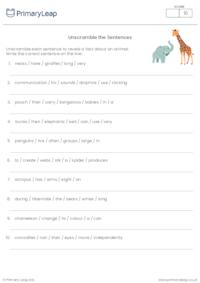
Engage your students with this fun and educational ESL worksheet designed to enhance their language skills through an interactive activity. This worksheet helps students practice sentence structure, vocabulary, and animal facts by unscrambling sentences related to various animals.Learning Objectives:Sentence Structure: Improve understanding of proper sentence formation.Vocabulary Building: Expand animal-related vocabulary in English.Critical Thinking: Develop problem-solving skills by rearranging words to form coherent sentences.Reading Comprehension: Reinforce reading skills through sentence unscrambling.Kids will unscramble each sentence to reveal an interesting fact about an animal. They should write the correct sentence on the line provided. This worksheet is perfect for classroom use, homework assignments, or additional practice at home. It offers a fun way for students to improve their English language skills while learning about the fascinating world of animals.
 Free
Free

Engage your students with a fun and educational ESL word search designed to expand their vocabulary and improve their spelling skills. This worksheet features a variety of animal names, making it an exciting activity for young learners. Learning Objectives:Vocabulary Building: Introduce and reinforce animal names in English.Spelling Practice: Help students recognise and correctly spell common animal names.Cognitive Skills: Enhance pattern recognition and problem-solving abilities as students search for words.Language Development: Improve reading skills and word recognition in a fun and interactive way.This word search is an excellent tool for both classroom and home use, providing a delightful way for students to improve their English language skills while learning about animals. Enjoy the process of discovering these fascinating creatures through a fun and educational activity!

Created for intermediate-level learners, this worksheet offers an exciting opportunity to reinforce understanding of adjectives and nouns in a familiar context.Students will dive into the captivating world of animals as they read a descriptive paragraph filled with colourful language. Through this engaging activity, they will identify and list adjectives and nouns used to describe various animals. This exercise not only strengthens their grasp of grammar but also enhances their vocabulary related to the animal kingdom.With clear instructions and a familiar topic, this worksheet is suitable for classroom use, tutoring sessions, or independent study. It provides a structured yet enjoyable way for students to practise language skills while learning about fascinating creatures.Download our "Animal Adjectives and Nouns Worksheet" today and watch as your students embark on a journey of language discovery amidst the wonders of the animal world!

This handy worksheet is perfect for helping students expand their English language skills while learning about different aspects of animals.With clear column headings for habitats, activities, animal descriptions, and food, students will practise categorising words related to animals in a fun and educational way. From the forests to the oceans, from hunting to hibernating, from fierce to fluffy, and from grass to leaves, this worksheet covers a wide range of vocabulary associated with the animal kingdom.Encourage students to carefully read the instructions and think critically about where each word belongs. As they categorise the words, they will strengthen their understanding of animal habitats, behaviours, characteristics, and dietary habits.This worksheet is suitable for ESL students, beginners, or any student looking to enhance their animal vocabulary in English. It can be used in the classroom, during tutoring sessions, or for independent study at home.
 Free
Free

Family Members ESL Unscramble the Words WorksheetEngage your young learners in a fun and educational activity with our "Family Members ESL Unscramble the Words Worksheet." This printable worksheet is designed to help children study and practise family members' vocabulary in an enjoyable way.Students will have the opportunity to unscramble the letters of family member names, such as "grandmother," "father," "sister," and more. By unscrambling the words, students will reinforce their spelling skills while also becoming more familiar with common family vocabulary.This worksheet is perfect for ESL students, beginners, or any child looking to expand their English vocabulary. It can be used in the classroom, at home, or as part of a tutoring session. It's a versatile resource that adds an element of fun to language learning.
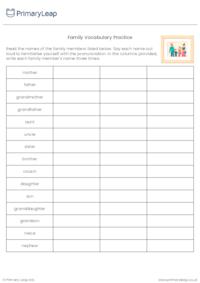
Empower your ESL students with our Family Vocabulary Practice Worksheet, designed specifically for beginners to reinforce their understanding and retention of essential family member names in English. This worksheet offers a structured and interactive approach to language learning, making it an ideal resource for educators seeking to enhance their students' vocabulary skills.With clear instructions and a user-friendly format, this worksheet encourages students to engage actively in the learning process. By writing each family member's name three times, students not only reinforce their spelling but also develop muscle memory, aiding in long-term retention of vocabulary.As educators, you can incorporate this worksheet into your lesson plans to provide valuable practice opportunities for your students. Whether used as an individual task or part of a group activity, this resource offers flexibility in implementation, catering to diverse teaching styles and classroom dynamics.Encourage your students to collaborate with peers, offering support and feedback as they work through the worksheet. This collaborative approach fosters a sense of community within the classroom and reinforces the importance of communication skills in language learning.Download our Family Vocabulary Practice Worksheet today and watch as your students gain confidence and proficiency in using family-related vocabulary.

My Family WorksheetEngage your young learners in a delightful exploration of family ties with our "My Family Worksheet." Designed to foster language development and strengthen familial connections, this worksheet provides an enjoyable opportunity for children to express themselves creatively while learning key vocabulary and language skills.Encourage your students or children to begin by drawing a picture of their family in the box provided. Whether it's Mum, Dad, siblings, grandparents, or even the family pet, this activity invites children to visually represent the cherished individuals in their lives.Next, on the lines provided, children can jot down information about each family member. From names and ages to professions and hobbies, this section encourages thoughtful reflection and expression as children articulate what makes each family member unique and special.

Family Vocabulary Word Search - Fun ESL ActivityLooking for an engaging way to help ESL students practise family vocabulary? Our Family Members Word Search is the perfect educational tool! This printable word search puzzle features essential family terms such as GRANDMOTHER, GRANDFATHER, MOTHER, FATHER, AUNT, UNCLE, SISTER, BROTHER, COUSIN, DAUGHTER, SON, GRANDDAUGHTER, GRANDSON, NIECE, and NEPHEW. Ideal for both classroom and home use, this activity not only enhances vocabulary skills but also provides a fun and interactive learning experience.Our Family Members Word Search is designed to be accessible and enjoyable for learners of all ages. It’s a great resource for teachers, parents, and tutors who want to reinforce family-related terms in a memorable way. Perfect for vocabulary lessons, ESL activities, and family-themed units, this puzzle will keep students engaged while they learn.Download and print our Family Members Word Search today to add a fun twist to your language learning sessions!

Challenge your ESL learners with this engaging crossword puzzle focused on rooms and areas of the house. In this worksheet, students will read clues about different rooms and spaces commonly found in a home environment and fill in the crossword puzzle grid with the correct words. This activity is designed to reinforce vocabulary related to house-related areas and promote language learning in a fun and interactive way.Key Features:Vocabulary Reinforcement: Help students practise and reinforce vocabulary words associated with rooms and areas of the house.Reading Comprehension: Improve reading comprehension skills as students read and interpret clues to complete the puzzle.Critical Thinking: Encourage critical thinking and problem-solving skills as students apply their knowledge of house-related vocabulary.Interactive Learning: Engage students in a hands-on activity that promotes active participation and learning.This ESL crossword puzzle is a valuable resource for reinforcing house-related vocabulary and fostering language development among ESL learners. Use it as part of a lesson on home environments or as a standalone activity to engage and motivate your students.

This ESL cloze activity worksheet is designed for elementary-level learners. The vocabulary and sentence structure are simple and suitable for young learners who are beginning to build their English language skills. The activity focuses on common rooms and items found in a house, providing an accessible and engaging way for elementary students to practice vocabulary and improve their reading comprehension. In this worksheet, students will fill in the blanks with the correct words from the word bank provided, reinforcing vocabulary related to household areas and objects.Key Features:Vocabulary Practice: Reinforce vocabulary related to rooms (e.g., dining room, bathroom) and household items (e.g., mirror, dishwasher).Contextual Learning: Enhance understanding of how different rooms and items are used within a home environment.Reading Comprehension: Improve reading comprehension skills by applying vocabulary in context.Critical Thinking: Encourage critical thinking as students select appropriate words to complete the sentences.

Engage elementary-level ESL learners with this interactive and challenging word unscramble activity focused on rooms and areas of the house. This worksheet features familiar words related to different living spaces, including living room, bedroom, dining room, bathroom, kitchen, office, garden, house, laundry room, and basement.Key Features:Vocabulary Practice: Reinforce vocabulary related to rooms and areas of the house through word unscrambling.Critical Thinking: Encourage critical thinking and problem-solving skills as students rearrange letters to form meaningful words.Language Skills: Enhance spelling, recognition, and understanding of English words associated with living environments.Independent Learning: Suitable for individual or group work, promoting autonomy and self-assessment.Enhance your students' vocabulary skills with this engaging word unscramble activity focused on rooms and areas of the house. Download and use it to create an interactive learning experience that reinforces language comprehension and critical thinking.
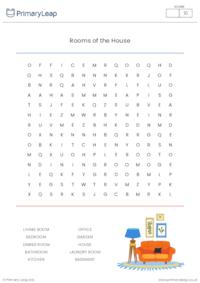
Engage elementary-level ESL learners with this fun and educational word search activity focused on rooms and areas of the house. This word search contains familiar words related to different rooms and spaces commonly found in a home, such as living room, bedroom, dining room, bathroom, kitchen, office, garden, house, laundry room, and basement.Learning Objectives:Recognise and spell common words associated with rooms and areas of the house.Develop cognitive skills through word search puzzle-solving.Encourage engagement and interest in learning English vocabulary related to living spaces.This ESL word search worksheet is designed to make learning vocabulary enjoyable and effective for elementary-level learners. Use it as a standalone activity or as part of a themed lesson on houses and living spaces.

Explore the different rooms of a house with this engaging ESL worksheet designed for elementary-level learners. This worksheet features six colourful images representing common rooms found in a home, along with corresponding vocabulary words: bedroom, living room, kitchen, garage, bathroom, and office.Learning Objectives:Identify and name common rooms found in a house.Practise spelling and recognising vocabulary related to living spaces.Develop basic comprehension skills through visual association and word-picture matching.This worksheet is ideal for introducing and reinforcing basic house-related vocabulary in a fun and interactive way. Use it in classrooms or at home to help learners build their English language skills while exploring the concept of home and living spaces.

This worksheet encourages ESL learners to develop descriptive writing skills by using advanced vocabulary to describe colours and their associated emotions or characteristics. Learning Objectives:Develop descriptive writing skills by describing natural scenes and weather phenomena.Expand vocabulary related to colours, emotions, and sensory experiences.Foster creative expression and self-awareness through reflective writing.This worksheet is ideal for intermediate to advanced ESL learners seeking to refine their descriptive writing abilities.
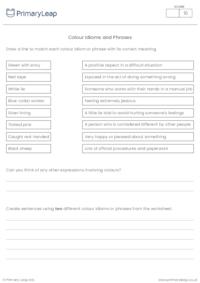
This handy ESL worksheet is designed to introduce and reinforce colour-related idiomatic expressions in English, enhancing vocabulary and comprehension skills. Kids will learn and practise idiomatic expressions related to colours while enhancing their vocabulary and understanding of figurative language. This worksheet is ideal for intermediate to advanced ESL learners seeking to enrich their language skills and explore the nuances of English expressions. Use this resource with your children in classrooms or at home and discover the vibrant world of expressions that add depth and colour to everyday conversations.

This ESL numbers quiz is designed for English language learners to reinforce fundamental numerical concepts and vocabulary. The quiz consists of 10 multiple-choice questions that cover basic knowledge about numbers and quantities. The goal of this worksheet is to assess and strengthen learners' understanding of essential numerical concepts in English, including counting, ordinal numbers, and basic arithmetic.This worksheet can be used in classroom settings by ESL teachers to gauge students' understanding of numbers and provide targeted support where needed. Parents can also use this worksheet as a supplemental learning resource at home to practise English numeracy skills with their children.
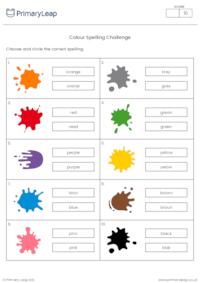
Colour Spelling ChallengeThis worksheet is a fun and educational activity that focuses on colour vocabulary and spelling. The objective of this activity is to reinforce colour-related vocabulary while improving spelling accuracy in English. The worksheet contains 10 colour swatches, each accompanied by two spelling options for the corresponding colour word (e.g., blue or bloo). Students are instructed to circle the correct spelling of each colour word based on the colour swatch provided.
 Free
Free

Hobbies Word SearchSuitable for various teaching settings, including in-class activities, homework assignments, or as a supplementary resource for language lessons, this worksheet adapts to the specific needs of educators and their ESL pupils. Students actively search for and identify hobby-related words in the puzzle, reinforcing vocabulary in an enjoyable context.

Hobby Matching WorksheetThis fun and engaging activity encourages students to read carefully and match each clue to the correct hobby from the word bank. From gardening to cooking and dancing, this worksheet provides a fun and interactive way for learners to strengthen their vocabulary and comprehension skills. Suitable for various teaching settings, including in-class activities, homework assignments, or as part of a broader language lesson, this worksheet adapts to educators' needs while providing valuable practice for students.

Adverbs ListThis three-page adverb list offers an extensive collection, providing students with a diverse range of adverbs to enhance their vocabulary. From commonly used adverbs to more nuanced expressions, this resource covers a wide spectrum of descriptive words.

Matching Opposites WorksheetBy drawing lines to connect words to their opposites and utilising visual aids, students will enhance their understanding of vocabulary and improve their ability to recognise and apply antonyms. This interactive activity aims to make learning opposites enjoyable and memorable.

Matching Opposites ESL WorksheetBy drawing lines to connect words to their opposites and utilising visual aids, students will enhance their understanding of vocabulary and improve their ability to recognise and apply antonyms. This interactive activity aims to make learning opposites enjoyable and memorable.
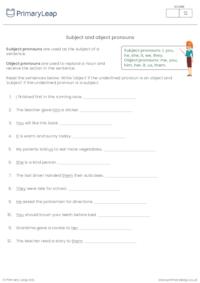
Subject and object pronouns worksheetExplore the world of pronouns with our "Subject and Object Pronouns" worksheet! This comprehensive activity will reinforce students' understanding of subject and object pronouns. By reading sentences and identifying whether the underlined pronoun serves as a subject or object, students practise the nuanced roles these pronouns play in sentence structure.

Using nouns in a sentenceThis activity will help enhance students' grasp of using nouns effectively in sentences. By completing sentences using nouns from the word bank, students not only reinforce their understanding of nouns but also practise constructing clear and meaningful sentences.

Personal pronouns worksheet This ESL activity focuses on enhancing students' understanding of personal pronouns by asking them to circle the pronoun that can replace the underlined word(s) in sentences. This hands-on exercise not only reinforces personal pronoun usage but also transforms grammar practice into an enjoyable and educational experience.

Personal pronouns worksheet This ESL activity focuses on enhancing students' understanding of personal pronouns by asking them to circle the pronoun that can replace the underlined word(s) in sentences. This hands-on exercise not only reinforces personal pronoun usage but also transforms grammar practice into an enjoyable and educational experience.

ESL Sorting nouns worksheetThis activity is designed to reinforce students' understanding of nouns as people, places, or things, while also sharpening their alphabetical order skills. Engage students in the process of categorising nouns and arranging them alphabetically, turning grammar practice into a fun and educational experience.

ESL Relative pronouns worksheetThis activity will help to strengthen students' understanding and usage of the most common relative pronouns: who, whom, whose, which, and that. Students will complete sentences by selecting the correct relative pronoun in brackets, offering an engaging and effective way to enhance their grammatical skills.
 Free
Free

Matching reflexive nounsThis engaging activity will reinforce understanding and usage of reflexive pronouns, which end in -self or -selves. Students are asked to draw lines to match the pronouns with their corresponding reflexive forms. Aligned with language development objectives, this worksheet not only reinforces reflexive pronoun usage but also helps students understand the unique properties of reflexive pronouns ending in -self or -selves.

Matching nouns to pronounsThis engaging activity is designed to reinforce understanding and usage of pronouns by inviting students to draw lines to match nouns with their corresponding pronouns. This exercise not only enhances grammar skills but also adds an element of fun to the learning process. Whether used in the classroom, as a homework assignment, or as part of a grammar lesson, this worksheet seamlessly integrates into various teaching settings. Its adaptability allows educators to cater to the specific needs of their students.




Check out our ready-to-use Themed worksheets that can be used in the classroom or at home. Simply download or print and watch your child’s confidence grow with our easy to follow Themed printables.


One of the best things about printable worksheets is that they make learning fun and easy. Explore our educational resources based on Themed and keep your children learning through these fun and engaging exercises.


Our Themed printable worksheets are designed for progressive learning. Our engaging content enables a child to learn at their own speed and gain confidence quickly. When we help a child believe in themselves, we empower them for life.


Printable worksheets are a great way to enhance creativity and improve a child’s knowledge. Help your child learn more about Themed with this great selection of worksheets designed to help children succeed.
An email has been sent to your account please activate your account to continue.

PrimaryLeap has introduced a new interactive learning platform and would like to offer you a completely Free Upgrade.
We understand that you may only want to use our services for worksheets and may not want to upgrade your account.
But if you are interested in trying out our new services then you're just a click away.
An email has been sent to your account please activate your account to continue.
You've answered
and have 2 Questions remaining
Import multiple students information through a CSV File. Browse or drag .CSV file below.